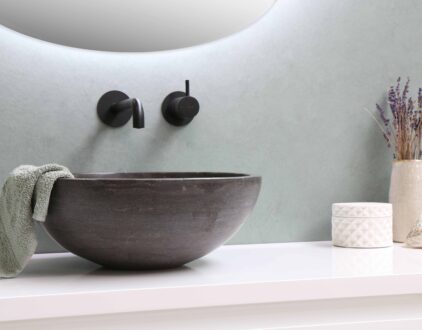When shopping for a TV, you may be under the impression that the first rule of thumb is to go big or go home. And while it may be tempting to get the biggest, baddest screen available, there are a few other factors you might want to consider. Of course, you’ll want to get the most TV for your value. But showing up informed can help you snag an even better piece of technology. Here’s a helpful guide for how to choose your perfect TV size.
Finding the Ideal Size
First things first: size does indeed matter when it comes to TVs. However, it’s not just about going big or going home. You want a screen size that’s just right for your viewing distance and room size.
Consider Your Space: Measure Twice, Buy Once
Before you leave your home or open your browser to go shopping, you’ll want to see what kind of space you have to work with. If you have a big, open wall, the sky’s the limit. But if you have to fit your screen above a fireplace or have limited square footage to work with, take measurements to figure out what’s the maximum size you can fit. Measuring diagonally will give you the best idea, as this is how TV sizes are measured. Don’t forget the minimum size, too. You’ll want to show up with a range of screen size varieties in mind while you browse.

Finding the Sweet Spot: Optimal Viewing Distance
Also, consider the distance of your couch and how you’ll be viewing it. While this all boils down to personal preference, the last thing you want is eye strain trying to squint at your new TV. Similarly, if you have a small living room, a gigantic TV might overwhelm the space.
Typical TV Sizes
The most common TV sizes include 42, 50, 55, 65, and 75 inches. Sure, you might stumble upon some models that fall in between these standard sizes, but such variations are few and far between, particularly as you venture toward the larger end of the spectrum.
Understanding Resolution
In displays, resolution refers to the number of pixels contained within an image. Why is this important? When grouped together, they form the building blocks of a complete picture. Essentially, the more pixels you have, the more detailed and sharper the image becomes, thus resulting in higher resolution.
Differences Between 1080p, Full HD, and 4K
1080p
This refers to a resolution of 1920 pixels horizontally by 1080 pixels vertically. Simply put, a 1080p image comprises over 2 million pixels. Now, you may have heard the term “Full HD” thrown around—well, that’s just another way of saying 1080p or 1920×1080. They’re all interchangeable terms for the same resolution.
4K
4K takes things up a notch. This resolution boasts an impressive pixel count of 3840×2160, totaling over 8 million pixels in the overall image. As you can imagine, the higher pixel density results in an incredibly sharp and detailed picture that’s a feast for the eyes.

The Catch: Original Recording Resolution Matters
It’s important to note that the quality of your viewing experience is ultimately limited by the original recording resolution. So, if you’re watching a video recorded in Full HD on a 4K monitor, the image won’t magically improve in quality. The screen may add more pixels, but they’ll simply serve as duplicates because the original recording didn’t capture as many unique pixels. In essence, your screen resolution is only as good as the video resolution you’re viewing.
8K
If you’re wondering if there is there anything beyond 4K, meet 8K, the pinnacle of resolution perfection. Devices boasting an 8K resolution have a pixel count of 7680×4320—amounting to over 33 million pixels in the total image. While the allure of 8K is undeniable, it’s worth mentioning that devices offering this resolution come with a hefty price tag, and you may not even realize the benefits unless you’re deeply invested in content creation or have access to super-high-resolution images.
Choosing the Right Resolution: A Balancing Act
When it comes down to it, selecting the right resolution boils down to a delicate balance of cost, quality, and practicality. Full HD (or 1080p) is often the most budget-friendly option and delivers satisfactory visuals for most viewing scenarios, particularly when streaming content from services like Netflix or Hulu. However, if you crave the utmost detail and clarity, 4K is the way to go—just keep in mind that it may come with higher energy consumption and storage demands.
Ultimately, whether you opt for 1080p, 4K, or even dare to venture into the realm of 8K, the key is to find the resolution that best suits your viewing preferences, budget, and technological needs.
popular posts
- 1It’s Black Business Month, So Let’s Go Shopping and #BuyBlack!
- 2These Home Decor Items Will Instantly Make Your Space Look Outdated
- 3Black-Owned Home Decor Stores To Support Across the United States
- 4A Look Inside Elon Musk's Tiny $50,000 House
- 57 Black and Multicultural Designers To Follow For Design Inspo

7 Bathroom Gadgets to Bring Your Toilette Into the 21st Century
by Stephanie Taylor | February 11, 2023

Make RiRi Proud With These Halftime Show Must-Haves
by Arielle Clay | January 30, 2023
Spaces
Whether it’s luxury or ease, every area of your home should be as fabulous and unique as you.

DIY Throw Pillows: These 5 Fabrics Add Both Texture & Culture
by homeandtexture | February 22, 2023
If You Enjoy Dinner With A Side Of TV, Give These Luxe Trays A Try
by Kelsey Marie | February 22, 2023
5 Coffee Table Books For The Art, Fashion and Culture Enthusiast
by Kelsey Marie | March 11, 2023
FOLLOW ALONG ON INSTAGRAM
#homeandtexture
Find us on social for more home inspiration where culture, personal style, and sophisticated shopping intersect to help you create a home where you love to live.





